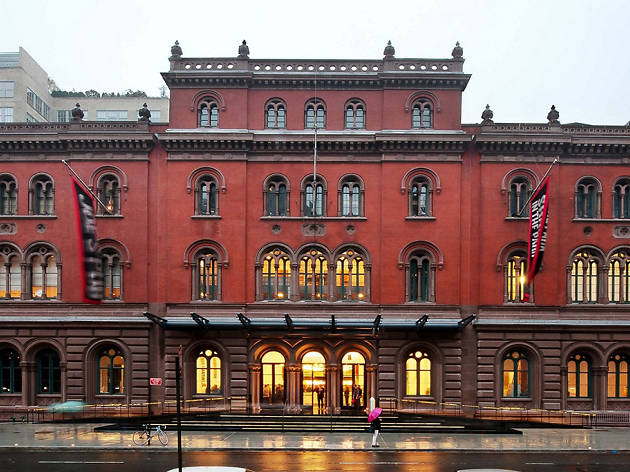
Like every building in New York City, there is a story to tell about how it came to be. When people walk by 636 Broadway, the first thing they notice is the black doors with an eye-catching shiny red 636 above the door. 636 is on a street that is notoriously known for attracting people all over the world to shop, and is significant in adding to the city’s culture. But what these passerbyers tend to look over are the people behind the operation, the ones who keep the building running-the person behind closed doors. The man responsible for keeping 636 Broadway alive is Victor Trager, whose family has owned the building for over forty years and are founding members of the NoHo BID.
636 Broadway was constructed in 1896 by an architect named George B. Post, famously known for constructing and designing the Equitable Life Insurance Building and the Williamsburgh Savings Bank. Once completed, 636 was bought by a man named Henry E. Coe, Jr.. When it was first built, it only had ten floors, but in 1905, Coe added on two more stories to make it the twelve story building it is today. The building remained under the Coe family’s ownership until the Depression years of the 1930s, at which point it was sold to Victor’s grandfather in 1946 where he sold and manufactured mainly women’s undergarments.
Herman I. Zacharia, Victor’s grandfather, came to own 636 Broadway during his time with the manufacturing business, and began to expand his business to the world of real estate. Along with his manufacturing facility, 636 was one of the many buildings in New York City owned by the Zacharia family. Although it may seem like Victor was born to be the landlord of 636 Broadway, it was not what he always intended to do with his life. After graduating college in the 1980s, Victor first went to work as an auditor for the City’s Comptroller’s Office. He was then given the opportunity to join the work being done at 636 Broadway. This job got Victor involved with the manufacturing companies renting out spaces in the 636, which included a military supplier on the 5th floor, and fabric companies all throughout the building. In the 80s, Victor’s uncle, who ran the manufacturing business when his grandfather passed away, decided to move the business out of New York City to expand and produce cheaper products, leaving a large vacancy at 636. With his uncle’s help, the manufacturing expanded to places like Puerto Rico and the Dominican Republic for less expensive manufacturing facilities. This change benefitted Victor’s family in many ways, one being that it gave Victor the position he has today, as 636 Broadway’s managing partner.
Over the years, Victor has worked with many different people in the world of real estate while continuing to lease spaces at 636 Broadway. One valuable detail Victor learned to factor into his knowledge of the real estate business is to adjust his methods along with the time. In other words, Victor began to evolve his leasing options as the market demands changed over time. For example, when people were looking to rent smaller spaces in New York City, Victor began to alter the sizes of his floor plans by breaking up full floors into smaller units to suit the needs of smaller companies, therefore creating shorter term leases and higher rents. This allowed Victor to fully rent out a floor thirty days after the construction was done. There is an article in the New York Times from the 1980s that mentions Victor’s plan for incorporating this method, where he spoke about how renting spaces paid more than manufacturing.This is why Victor converted 636 Broadway to an office building with both small and large spaces to accommodate different tenant’s needs.
In Victor’s eyes, the secret ingredient to being a good landlord is flexibility. When asked how many spaces people tend to occupy at a time, Victor’s response gravitated towards the compliance of the tenants and the different businesses they have created. He stated that, ”The beauty of these small spaces is that if somebody wanted to expand their business, and the spaces on either side were available, they would be able to expand without moving their room number or their zip code or address. It would be very easy to expand, or even reverse if need be. For example if a business needed to downsize, we could just put up another wall and door for a new office. It’s all very flexible, and I try to make it as flexible as possible because of the competitive market.” Over the years, Victor has had small businesses start with only 1,000 square feet, and watched them expand to entire floors of 11,000 square feet.
As previously stated, many of the tenants that occupy 636 Broadway are start up businesses. Most tenants remain in the building for the entire life of the business, and many of Victor’s occupants have been a part of 636 Broadway for numerous years. This is an aspect of being a landlord that Victor enjoys because he witnesses the evolution of businesses as they build from the ground up. Part of the reason why these small businesses are able to expand so easily is due to a nontraditional philosophy that Victor integrates into his leasing. Instead of following what most landlords tend to do by having potential tenants sign a ten year lease, Victor gives these businesses a three-to-five year lease. This allows small businesses to have an easier start, and also grants them the option to stay a part of 636 Broadway for as long as they need to without the fear of failure. It is because of important details like this that we must applaud Victor for his contribution to so many businesses.
For those who do not know Victor personally, one important detail to know about him is that he is very passionate and highly respected by his tenants. To Victor, the most important ingredient to being the landlord of 636 Broadway is developing personal relationships with all of his tenants, and making sure to put a lot of time and effort into taking care of his residents needs.
For example, one of the businesses Victor has seen grow over the years is NoHo Productions, which was one of his first tenants when the building switched from manufacturing to renting office spaces. NoHo Productions began in the late 1980s, and started by only occupying 1,000 square feet. Since then, NoHo Productions has expanded immensely, now renting 22,000 square feet of space which is equivalent to two full floors. NoHo Productions is a company that offers high-end, full-service photography rental studios by day, week, or depending on however long the job may take.
Another business occupying 636 Broadway is Print Mor, a mom and pop full service print shop that can produce menus, flyers, posters, business cards, social-distancing signs, and other assortments of products. When Print Mor could no longer afford a storefront on Bleecker Street, Victor offered them space on the 7th Floor and gave them the opportunity to not only continue their business, but also to expand.
You may also know of Work, Train, Fight, a boxing and fitness gym. It offers multiple boxing and fitness classes throughout the week, both public and private. Work, Train, Fight began with only a few personal trainers and a small space in the building. Now, their business has expanded to take up the entire 2nd floor.
Over the years that Victor and his family have owned 636 Broadway, he has encountered many fascinating tenants, including a few celebrities. Notable tenants include Naomi Campbell and Joan Jett. Broadcast Media Arts produced Budweiser ads for the Super Bowl, and a Pee-Wee Herman series in the 1980s. Also Emilio Ambasz, an architect, was one of Victor’s first office tenants. Ambasz designed the lobby and elevator plans for 636 as part of his rental agreement with Victor, stating that his help along with his presence was somewhat of “a package deal.” Ambasz rented out the entire 11th floor, and is very significant to the transition from manufacturing to office tenancies.
When asked what the hardest part about being a landlord was, Victor’s response was adapting to the constant change in building regulations. Along with regulations, 636 Broadway faces the ongoing challenge of the area’s manufacturing zoning being out of date with current desired uses for the spaces. Over the years, the population and economic status of NoHo has vastly changed since the 1960s when the zoning was last codified. Although this change is widely known, the zoning rules established in the 1960s have not yet been updated to adjust to the current atmosphere of the neighborhood. One example of this is prohibiting ground floor retail spaces for buildings like 636 Broadway. By updating these zoning regulations, it would allow the process of renting to tenants to become easier and much more efficient. This would allow businesses to grow and help not only 636 Broadway, but all landlords in the surrounding area too.
This would also help to repair some of the damage faced in the wake of the 2020 COVID-19 pandemic. With no clear idea of when the pandemic will end, real estate owners like Victor will continue to adjust to the impacts that the virus leaves in its wake. Victor has helped his tenants by continuing to work very closely with them and offering creative opportunities to stay if it all possible during these unsettling times. Victor feels that things may become worse before they will improve, but understands that he nor anyone else can predict how long the recovery will take once the pandemic is over. Victor is a wonderful landlord, for those looking to rent, please contact him here, and he will try to do everything to help support your business!





